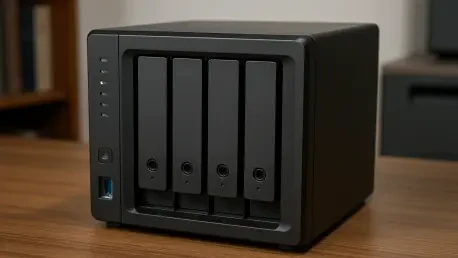In an era where digital content like family photos, critical work documents, and personal videos are increasingly central to daily life, the question of how to store and protect this data has never been more pressing, especially as commercial cloud storage services raise subscription fees and scale back free storage options. With many individuals and businesses grappling with the dual challenges of cost and privacy, reports of user data being utilized to train artificial intelligence models without explicit consent have further eroded trust in these platforms. Amid this backdrop, Network Attached Storage (NAS) devices have emerged as a compelling alternative, offering a private, fee-free solution that puts control back into the hands of users. This shift represents not just a technological pivot but a return to the fundamental principle of data sovereignty, where individuals manage their digital assets directly from the comfort of home.
The Rising Appeal of Personal Storage Solutions
Privacy Concerns Driving Change
The mounting unease over privacy violations in commercial cloud storage has become a significant catalyst for change in how data is managed. Many users are unaware that their personal files, uploaded for safekeeping, may be analyzed or repurposed by third parties for purposes beyond simple storage. This lack of transparency has sparked widespread concern, especially as stories surface about data being used without clear permission. Home NAS systems address this issue head-on by keeping all information within a user’s private network, eliminating the risk of external access or exploitation. Unlike cloud services hosted on distant servers, a NAS device resides physically in one’s home, ensuring that sensitive content remains under personal oversight. This direct control offers peace of mind, particularly for those handling confidential materials or cherished memories that demand the highest level of protection against unauthorized use.
Cost Efficiency in the Long Run
Beyond privacy, the financial aspect of data storage cannot be overlooked as subscription costs for cloud services continue to climb. What once seemed like an affordable convenience has transformed into a recurring expense that adds up over time. In contrast, investing in a NAS device presents a one-time cost that can rival just a couple of years of cloud fees, especially when opting for models with substantial storage capacity. This upfront investment eliminates the burden of monthly bills, providing a budget-friendly alternative for long-term data management. Additionally, the absence of ongoing fees means users can allocate resources elsewhere while still enjoying robust storage capabilities. For families or small businesses with growing digital libraries, this economic advantage makes NAS an attractive option, aligning financial savings with the practical need for expansive, reliable space to house important files.
Key Advantages and Considerations for NAS Adoption
Unmatched Control Over Digital Assets
One of the standout benefits of adopting a home NAS system lies in the unparalleled control it grants over digital assets. Unlike cloud platforms where policies and access rights are dictated by external providers, NAS empowers users to define who can view or share their content through customizable settings. This autonomy extends to organizing data in a manner that suits individual preferences, whether for personal use or collaborative projects within a household or small team. Furthermore, NAS devices often support secure remote access, allowing files to be retrieved from anywhere without compromising safety. This balance of accessibility and authority ensures that users are not at the mercy of third-party decisions or unexpected policy shifts, fostering a sense of ownership over every byte of data stored within the system’s drives.
Security and Reliability as Top Priorities
When transitioning to a home NAS setup, prioritizing security and reliability becomes paramount to safeguard against potential risks. Opting for devices with advanced encryption—both for data at rest and during transfer—is essential to protect against breaches. Features like two-factor authentication and detailed access management further fortify defenses, ensuring only authorized individuals can interact with the system. Reliability is equally critical, with multi-bay NAS units recommended over single-bay models to enable RAID configurations that guard against data loss from drive failures. Automatic backup options, ideally to separate drives or locations, add another layer of assurance. Power efficiency also plays a role, with systems offering scheduled management helping to reduce costs and enhance security by limiting active hours. These considerations collectively ensure that a NAS solution matches the robustness of commercial alternatives while meeting specific user needs.
Ease of Use for All Skill Levels
A common misconception about home NAS systems is that they require advanced technical expertise, but modern devices have shattered this barrier with user-friendly designs. Many come equipped with intuitive applications for mobile synchronization, streaming, and remote access, making them accessible even to those with minimal tech experience. This democratization of technology means that transitioning from cloud storage to a personal system is smoother than ever, with setup processes streamlined for simplicity. Manufacturers have focused on creating interfaces that guide users through configuration and maintenance, reducing the likelihood of errors due to complexity. As a result, individuals from varied backgrounds can confidently adopt NAS, knowing that consistent operation and effective data management are within reach without the need for specialized knowledge or constant troubleshooting.
Reflecting on a Shift to Data Sovereignty
Looking back, the move toward home NAS systems marked a pivotal response to the growing frustrations with commercial cloud storage, particularly around escalating costs and invasive privacy practices. This transition highlighted a collective desire to reclaim authority over personal and professional data, echoing earlier eras of computing where localized control was the norm. The detailed exploration of NAS benefits, from financial savings to robust security features, underscored how these devices met the needs of a diverse user base seeking reliable alternatives. As a next step, those considering this shift were encouraged to evaluate NAS options based on encryption strength, redundancy capabilities, and operational simplicity to ensure a seamless fit. This journey toward data sovereignty not only addressed immediate concerns but also paved the way for future innovations in personal storage, promising even greater empowerment for users navigating an increasingly digital world.









